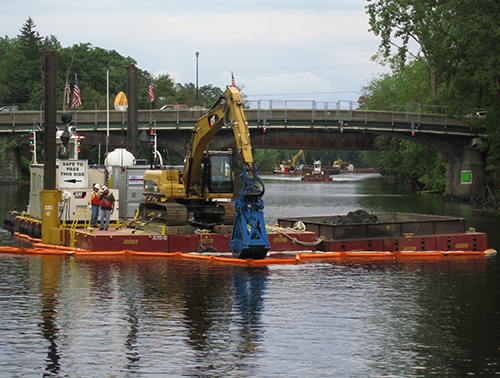Remedial Injury Determination Report Released for Hudson River, New York
February 19, 2021
The Natural Resource Trustees for the Hudson River PCBs Superfund Site in New York have released a Remedial Injury Determination Report. The Trustees determined that dredging to remove polychlorinated biphenyls (PCBs) from the upper Hudson River between Fort Edwards and the Federal Dam at Troy caused injuries to natural resources such as wetlands, aquatic vegetation beds, freshwater mussels, and shoreline trees.
Beginning in 1947 and continuing for approximately 30 years, General Electric used and released millions of pounds of PCBs into the upper Hudson River. Over time, PCBs contaminated nearly 200 miles of the Hudson River and beyond into New York/New Jersey Harbor, making it the country's largest Superfund site.
Under a consent decree with the U.S. Environmental Protection Agency, General Electric was required to dredge about 500 acres of PCB-contaminated sediment from 40 miles of the Hudson River between Fort Edward and Troy, New York. General Electric conducted the remedial dredging between 2009 and 2015. The Trustees used GE’s technical documents to examine the impact of remedial work on vegetated habitats in those areas and results of Trustee sponsored surveys of freshwater mussels.
- Dredging and subsequent capping and/or backfilling of the Hudson River, harmed the following habitats: 30 acres of wetlands along the river were destroyed. Wetlands are habitat for fish, frogs, reptiles, mammals, and birds, including waterfowl. Wetlands also contribute to flood resiliency, sediment stability, and carbon and nutrients within the aquatic food web.
- 133 acres of aquatic vegetation (submerged and floating) were dredged. These plants provide wildlife with food and habitat, add oxygen to the water, cycle nutrients, trap sediment, dissipate energy and reduce erosion.
- More than 50 million freshwater mussels were killed by sediment removal. Freshwater mussels are nature’s equivalent of a water filter, each individual mussel filtering up to 3 gallons of river water per day, depending on species and size. Freshwater mussels add structure to the river bottom, cycle nutrients,provide habitat to other organisms and are an important source of food for fish and wildlife.
- More than 3,000 trees along the shoreline were removed, and 152 trees were trimmed for dredging access. These riverbank woodlands improve water quality, filter nutrients, reduce soil erosion, buffer flood flows, provide habitat for wildlife and strengthen bank stability.
GE implemented habitat reconstruction as part of the remedy, including wetland planting and seeding, aquatic vegetation bed reconstruction and limited shoreline tree planting. Other than backfill placement to sequester residual PCBs and also enhance recovery of river bottom-dwelling organisms, no other efforts by GE were taken to address freshwater mussels adversely impacted by the remedy. Monitoring indicates that these natural resources have not recovered and will take decades to reach pre-dredging conditions. The Trustees incorporated the destruction and losses caused by the remedial action,into the determination of injury.
The Comprehensive Environmental Response, Compensation and Liability Act (CERCLA) provides that the public be compensated when the cleanup of hazardous substances in the environment, such as PCBs in river sediment, causes natural resource injuries. Injuries caused by cleanup are compensable, as these injuries result from a release of hazardous substances.
The full report is available for the public online: Determination of Injury to Natural Resources from Remedial Activities on the Hudson River: Riverine Fringing Wetlands, Aquatic Vegetation Beds, Shoreline Trees, and Native Freshwater Mussels. A fact sheet is also available.
A final quantification of the injury, including interim losses, will be provided in a subsequent report. All public Case Documents for the Hudson River Natural Resource Damage Assessment are accessible on NOAA’s DIVER Website.







